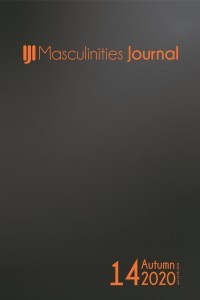Hiper-Maskülen Bir Mutfakta Bir Gey: Oto-Etnografik Bir Anlatı
Bu kısa oto-etnografik anlatı, kuir bir erkek hiper-maskülen bir mekanda bulunduğunda, hegemonik erkekliğin üstüne nasıl gidildiğini, onunla nasıl yüzleşildiğini ortaya çıkarmaktadır. Gey bir erkeğin bir restoran mutfağında çalıştığı bir yılın en önemli anlarını betimleyebilmek için, makalenin literatür taramasında ele alınan gey estetik, erkeklik sigortası ve işçi sınıfı erkekliği gibi temalar, Goffman’ın teorisine dayanan bir sembolik etkileşimci perspektif ile bir arada kullanılmıştır. Bu araştırma, mutfak üzerine yürütülen sosyolojik çalışmaların eksik bıraktığı erkeklik boyutunu ele almakta; bunu da konusuna erkeklik üzerine yapılan, sınıfsal ve kuir kimlik perspektifini içeren güncel çalışmalar üzerinden yaklaşarak yapmaktadır. Oto-etnografik bir anlatı olan bu çalışma, araştırma öznelerinin içsel deneyimlerini, hegemonik erkeklikle yürüttüğü diyalogu doğrudan bir araştırma konusu olarak ele alarak, akademik alana taşımaktadır.
Anahtar Kelimeler:
Hegemonik erkeklik, işçi sınıfı erkekliği, oto-etnoloji, Goffman, damga, gey, kuir
A Gay Man in A Hypermasculine Kitchen: An Autoethnographic Account
This brief auto-ethnographic account explores the way hegemonic masculinity is confronted when a queer male inhabits a hyper-masculine space. Themes from the literature review such as gay aesthetics, masculinity insurance, and working class masculinity are intermingled with a symbolic interactionist perspective rooted in Goffman to describe key moments from a year spent in the back of a kitchen as a gay male. Where sociological work on kitchens leaves out a conversation of masculinity this research confronts this gap head on by approaching it with current research on masculinity especially as it mingles with a classed and queer identity. As an auto-ethnographic account this study is able to bring the subjects internal experiences into the academic field speaking with and back to the discourse on hegemonic masculinity directly as a research subject.
Keywords:
Hegemonic masculinity working-class masculinity, auto-ethnography, , Goffman, stigma, gay, queer,
___
- Anderson, E. (2002). Openly gay athletes: Contesting hegemonic masculinity in a homophobic environment. Gender and Society, 16(6), 860-877.
- Baron, A. (2006). Masculinity, the embodied male worker, and the historians gaze. International Labor and Working-Class History (69), 143-160.
- Bird, S. (1996). Welcome to the men's club: Homosociality and the maintenance of hegemonic masculinity. Gender and Society 10 (2), 120-132.
- Bridges T. (2014). A very “gay” straight?: Hybrid masculinities, sexual aesthetics, and the changing relationship between masculinity and homophobia. Gender and Society, 28 (1), 58-82.
- Connel, R. W. & Messerschmidt, J. W. (2005). Hegemonic masculinity: Rethinking the concept. Gender and Society, 19 (6), 829-859.
- Denzin, N. (2014). Interpretive autoethnography, Qualitative research methods (2nd ed., v. 17). Thousand Oaks, California: SAGE.
- Fine, G. (1996). Kitchens the culture of restaurant work. (2nd ed.). Berkeley, CA ; London: University of CA Press.
- Gamson, J. (2005). The intersection of gay street and straight street: Shopping, social class, and the new gay visibility. Social Thought & Research, 26 (1/2), 3-18.
- Gilbert, D. (2008). The American class structure in an age of growing inequality. (7th ed.). Los Angeles: Pine Forge Press.
- Goffman, E. (1963). Stigma; notes on the management of spoiled identity. (Spectrum book). Englewood Cliffs, N.J.: Prentice-Hall.
- McCormack, M. (2011). Hierarchy without hegemony: Locating boys in an inclusive school setting. Sociological Perspectives, 54(1), 83-102.
- Morris, E. (2008). “Rednecks,” “rutters,” and 'rithmetic: Social class, masculinity, and schooling in a rural context. Gender and Society, 22(6), 728-751.
- Nayak, A. (2006). Displaced masculinities: Chavs, youth and class in the post-industrial city. Sociology, 40(5), 813-831.
- Roberts, S. (2013). Boys will be boys … won't they? Change and continuities in contemporary young working-class masculinities. Sociology, 47(4), 671-686.
- Satterlund, T. D. (2012). Real, but not too real: A hierarchy of reality for recreational middle-class boxers. Sociological Perspectives, 55(3), 529-551.
- Scheff, T. (2006). Goffman unbound!: A new paradigm for social science. (Advancing the sociological imagination). Boulder, Colo.: Paradigm.
- Schrock, D & Schwalbe, M. (2009). Men, masculinity, and manhood acts. Annual Review of Sociology, 35 (NA), 277-295.
- Başlangıç: 2014
- Yayıncı: Eleştirel Erkeklik İncelemeleri İnisiyatifi
Sayıdaki Diğer Makaleler
Bangladeş’te Babalık İcrası: Değişen Roller, Sorumluluklar ve İki Kuşak Babaların Katılımı
Hiper-Maskülen Bir Mutfakta Bir Gey: Oto-Etnografik Bir Anlatı
Annie Proulx’un Wyoming Stories’i: Amerika’nın Batısında Hegemonik Erkekliğin Yapısökümü
Contemporary Masculinities in the UK and the US: Between Bodies and Systems
Erkeklerin örgütsel alanlardaki konumunu yeniden düşünmek: Fransız Deneyimi
